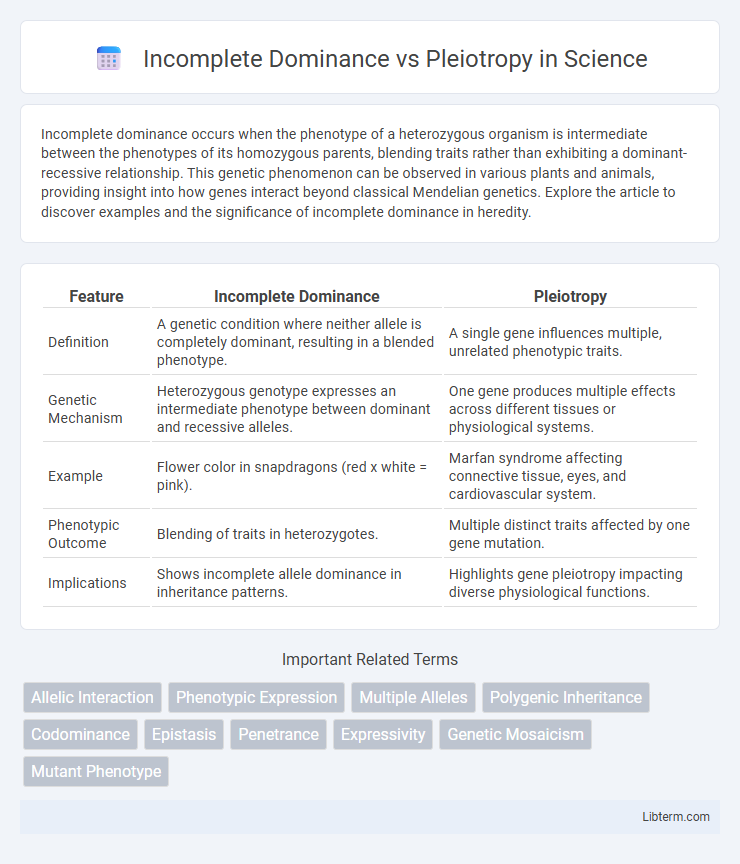Incomplete dominance occurs when the phenotype of a heterozygous organism is intermediate between the phenotypes of its homozygous parents, blending traits rather than exhibiting a dominant-recessive relationship. This genetic phenomenon can be observed in various plants and animals, providing insight into how genes interact beyond classical Mendelian genetics. Explore the article to discover examples and the significance of incomplete dominance in heredity.
Table of Comparison
| Feature | Incomplete Dominance | Pleiotropy |
|---|---|---|
| Definition | A genetic condition where neither allele is completely dominant, resulting in a blended phenotype. | A single gene influences multiple, unrelated phenotypic traits. |
| Genetic Mechanism | Heterozygous genotype expresses an intermediate phenotype between dominant and recessive alleles. | One gene produces multiple effects across different tissues or physiological systems. |
| Example | Flower color in snapdragons (red x white = pink). | Marfan syndrome affecting connective tissue, eyes, and cardiovascular system. |
| Phenotypic Outcome | Blending of traits in heterozygotes. | Multiple distinct traits affected by one gene mutation. |
| Implications | Shows incomplete allele dominance in inheritance patterns. | Highlights gene pleiotropy impacting diverse physiological functions. |
Introduction to Genetic Inheritance
Incomplete dominance occurs when neither allele is completely dominant, resulting in a heterozygous phenotype that is a blend of both parental traits, such as pink flowers from red and white parents. Pleiotropy refers to a single gene influencing multiple phenotypic traits, exemplified by the gene responsible for Marfan syndrome affecting connective tissue, heart, and eye abnormalities. Both incomplete dominance and pleiotropy demonstrate the complexity of genetic inheritance beyond simple dominant-recessive patterns, highlighting gene interactions and variable phenotypic expressions.
Defining Incomplete Dominance
Incomplete dominance occurs when a heterozygous genotype produces a phenotype that is intermediate between the two homozygous phenotypes, resulting in a blended expression of traits. Unlike pleiotropy, where one gene influences multiple phenotypic traits, incomplete dominance specifically describes the partial expression of alleles at a single gene locus. Examples include the pink flowers of snapdragons resulting from red and white allele combinations.
Explaining Pleiotropy
Pleiotropy occurs when a single gene influences multiple phenotypic traits, creating a wide range of effects on an organism's biology. Unlike incomplete dominance, which involves the blending of alleles at one locus to produce an intermediate phenotype, pleiotropy extends one gene's impact across different physiological functions or structures. For example, the gene responsible for Marfan syndrome affects connective tissue, impacting the heart, eyes, and skeleton simultaneously.
Key Differences Between Incomplete Dominance and Pleiotropy
Incomplete dominance occurs when a heterozygous genotype results in a phenotype that is a blend of both alleles, such as pink flowers from red and white parents. Pleiotropy involves a single gene influencing multiple, seemingly unrelated phenotypic traits, exemplified by the sickle cell gene affecting blood cells and susceptibility to malaria. The key difference lies in incomplete dominance governing phenotype expression within a single trait, while pleiotropy impacts multiple traits through one gene mutation.
Examples of Incomplete Dominance in Nature
Incomplete dominance occurs when neither allele is completely dominant, resulting in a heterozygous phenotype that is an intermediate blend of the two homozygous traits. Classic examples include snapdragon flower color, where red and white alleles produce pink blooms, and certain breeds of chickens like Andalusians, which show blue feathers due to incomplete dominance between black and white feather color alleles. This contrasts with pleiotropy, where a single gene influences multiple phenotypic traits, such as the Marfan syndrome gene affecting connective tissue in various organs.
Notable Cases of Pleiotropy in Organisms
Notable cases of pleiotropy in organisms include the Marfan syndrome gene, which affects connective tissue, causing symptoms in the heart, eyes, and skeleton. Another example is the sickle cell gene, where a single mutation alters red blood cell shape and provides malaria resistance. These instances demonstrate how one gene influences multiple, seemingly unrelated phenotypic traits, differing from incomplete dominance where intermediate phenotypes arise from allele interactions in a single trait.
Mechanisms Underlying Incomplete Dominance
Incomplete dominance arises when heterozygous alleles produce an intermediate phenotype due to neither allele being fully dominant, resulting in a blended expression of traits. This mechanism involves the partial synthesis of pigments or proteins encoded by each allele, leading to a phenotype that is distinct from both homozygous conditions. Molecularly, incomplete dominance reflects the dosage effect of alleles where the amount of gene product correlates with the phenotypic intensity.
Genetic Pathways Leading to Pleiotropic Effects
Incomplete dominance occurs when heterozygous alleles produce an intermediate phenotype, reflecting a blending of traits, while pleiotropy involves a single gene affecting multiple distinct phenotypic traits through its influence on several biological pathways. Genetic pathways leading to pleiotropic effects often involve a gene encoding a protein that participates in multiple signaling cascades or regulatory networks, thereby impacting diverse cellular functions and developmental processes. For example, mutations in the transcription factor gene PAX6 can cause pleiotropic effects, affecting eye development, neural differentiation, and pancreatic function simultaneously due to its role in key genetic regulatory pathways.
Biological Significance and Impact on Phenotypes
Incomplete dominance results in phenotypes that are intermediate between two alleles, providing a spectrum of trait variations crucial for genetic diversity. Pleiotropy occurs when a single gene influences multiple, seemingly unrelated phenotypic traits, profoundly affecting organismal development and function. Both mechanisms highlight complex genetic interactions, with incomplete dominance affecting single-trait expression and pleiotropy impacting multiple biological systems simultaneously.
Summary: Incomplete Dominance vs Pleiotropy
Incomplete dominance occurs when two alleles blend to produce an intermediate phenotype, such as pink flowers from red and white parents. Pleiotropy involves a single gene influencing multiple unrelated traits, exemplified by the wide-ranging symptoms caused by sickle cell anemia. These distinct genetic mechanisms highlight how gene expression can affect organism traits either through blending effects or multifaceted gene impact.
Incomplete Dominance Infographic

 libterm.com
libterm.com